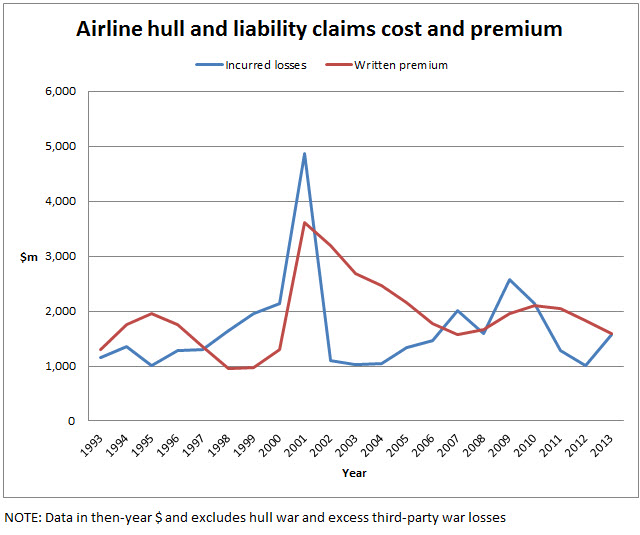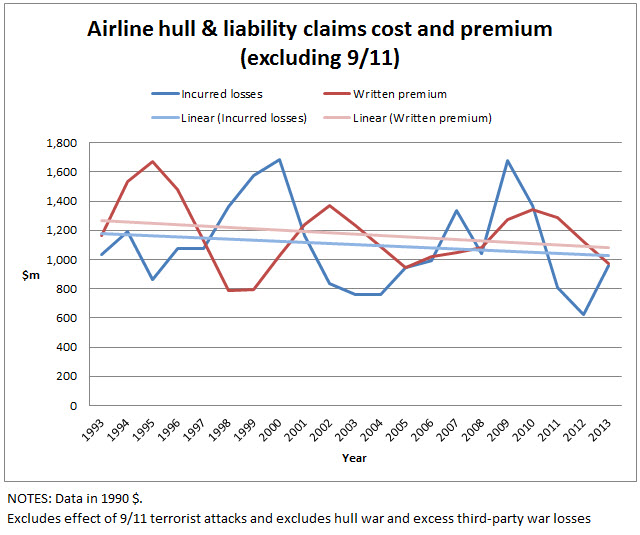Last year was another good period from the point of view of airline safety but, with incurred losses equalling written premium in the year, it was not so good for insurers, writes Paul Hayes, director of air safety and insurance with Flightglobal advisory service Ascend.
Flightglobal estimates that the cost of incurred airline hull and legal liability losses for 2013 was about $1.57 billion. This is some $530 million more than in 2012, when losses estimated at just $1.04 billion were incurred, and effectively equal to the estimated $1.6 billion of premium written during the calendar year.
Despite the expected cost of claims being more or less the same as the written premium, claims costs for 2013 were not exceptionally high and could perhaps be described as “average”. It is rather that premiums are low, having fallen by almost 25% since the last “high” in 2010.
The level of incurred claims should not have come as a surprise to the market, as it could have been predicted several months ago at least. However, this does not seem to have stopped or even slowed the continuing collapse in airline insurance rates and premium income, with reductions for most programmes still being given through to the end of the year.
The question is whether 2013 represents the bottom of the soft market. It is understood that there has been “some resistance to further reductions” for April renewals (there are few airline renewals during the first quarter) with “pre-quotes as before” – that is, no increase but also no further reduction. But this may just mean that insurers that try to “hold the line” will end up writing less business. There is a lot of competition out there. With the soft market conditions and new insurance capacity still looking to gain market share, if there are no significant losses we believe that rates – and possibly premiums – will continue to fall in 2014. Apart from anything else, if there are no significant losses, there will almost be an expectation of further reductions from insurance buyers for risks that have gone clean during the year. After all, everyone else has been getting reductions.
Nevertheless, we do expect that 2014, even without a significant loss, will mark the end of the current general fall in premiums. But without a reduction in insurance capacity and/or a marked deterioration in the loss experience, there will be nothing to begin driving premiums and rates up again. For insurers, this may be as good as it gets for a while.
With reduced premium income from the major airline programmes, established aviation insurers have been managing their books of business to attempt to maintain profitability. Insurers may reduce their line (the percentage of the risk they insure) or decline risks they think are just too cheap – but there has also been a gradual re-profiling of the business they write: perhaps less exposure to major airlines, but increased exposure to third- and fourth-tier airlines, product manufacturers and service providers, and general aviation.
The airline insurance market is traditionally described as cyclical with an eight- or nine-year cycle between premium income troughs. However, recent history has been distorted and totally dominated by the losses incurred as a result of the 9/11 terrorist attacks and their impact on airline insurance premiums in the following years.


If the incurred losses falling on airline policies for 9/11 are removed and the written premium figures are adjusted to reflect what they might have been if this event had never happened, then the numbers expressed in real terms (1990 $) reveal a different picture. The premium cycle is still there and not surprisingly follows the loss cycle – more or less – but the overall long-term trend for both losses and premium is slightly downward. Last year’s position is slightly below the long-term trend for both premium and claims.
The slope of the trend lines for both premium and losses is virtually identical, and shows a fall of between 10 and 15% in real terms for both over the last 20 years.
Premiums exceed claims in this presentation – but only just. In the long term, premium has been exceeding claims by only about 5 or 6%. Considering that, with low interest rates, there is nowadays only limited scope for insurers to generate investment income, a 5 or 6% margin is not enough to meet the running costs of the business, provide a reasonable return on the capital employed and, perhaps, make a small profit. It has been said that, as a rule of thumb, a margin of at least 20% is needed to meet running costs with any profit coming on top.
Clearly, the insurance market is living in interesting times.
Source: Airline Business
















